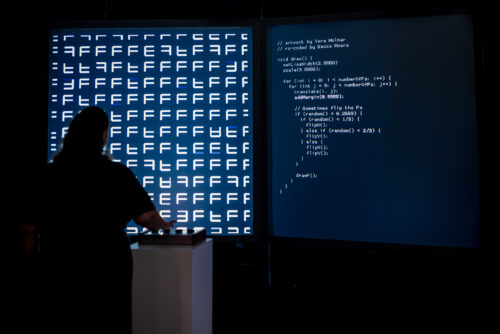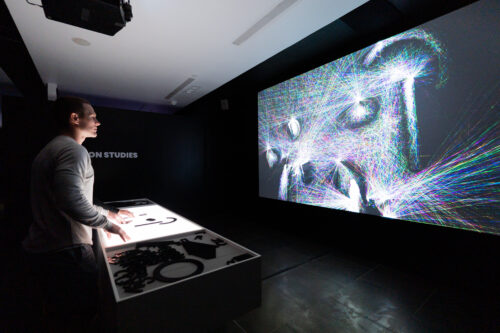Visual Art
At Artechouse, computer code becomes poetry

The cinematic compilation (“Sketches”) combines Zach Lieberman’s edited sketches with music from Jemapur, Daito Manabe, and Nahre Sol in “Future Sketches / Code Poems” at Artechouse, Miami Beach, through May 27. (Photo courtesy of Artechouse)
Artechouse, nestled amid the cultural scene of Miami Beach, is a place where art and technology come together. With its latest exhibition, “Future Sketches / Code Poems,” Zach Lieberman’s work explores the transformative potential of technology on human expression and poetry in particular.
“Future Sketches / Code Poems” invites visitors to explore what coding feels like, what it looks like, and how they can get creative with it.
“Most people think of computer code as sort of soul-less and logical, and that makes sense, since it’s a technical medium based on math. But also, there’s such beauty that you can find in math, and I personally try to find in my work organic, playful and engaging forms that talk more about what it means to be human and what it means to be alive,” says the artist and curator of the exhibit.

An artistic rendition of a portrait of Zach Lieberman, the driving force behind the exhibit “Future Sketches / Code Poems.” (Photo courtesy of Artechouse)
Lieberman offers insights into the exhibition’s inspiration and thematic element and explains his creation process.
“I am an artist who works with code, but I strive to create organic, natural, and playful pieces. I thoroughly enjoy sketching and crafting within this medium, and I aim to provide people with an opportunity to experience the sensation of almost living within my sketchbook.”
The tech-poet explains that “Poetry is a medium of words where you try to use the right words in the right order to express something hard to express about the world. In code, you also have to use precise words in the precise order, but in this case to tell the computer to do something.”
“Future Sketches / Code Poems” is presented as a love letter to animation, interaction, and computation, with a focus on creating immersive and engaging experiences for visitors. The exhibition features different sections, each allowing viewers to engage with the artwork, from the “Daily Sketches” showcasing evolving artistic expressions to the “Re-Coded” section, where visitors can interact with recreated artworks using code.
“In this exhibit, there’s a variety of experiences — from more passive works, which are kind of ‘lean back and use your imagination,’ to ‘lean forward’ works where you bring your voice, your body, your face and your input to bring the work to life. In all cases (except for some prints) the works are moving, and the goal is to create a playful, engaging and inspiring experience.”

A visitor interacts with the artwork “Re-Coded,” which is an homage to innovators such as Vera Molnar and Muriel Cooper, whose work exists in the space between art and technology. (Photo courtesy of Artechouse)
The inclusion of musical pieces curated by artist Daito Manabe adds another layer of depth to the exhibit, enhancing the overall sensory experience.
“I am primarily a visual artist,” says Lieberman, “but I thought the exhibit could be too quiet if the work was 100 percent visual. “Manabe helped produce the music for this show. He has an organic style but also a feeling of computation comes through.”
The exhibit is touted as both immersive and interactive, encouraging museum-goers to actively engage with the artwork, blurring the lines between observer and creator.
“You know when you go to a museum and you see signs that say, ‘Don’t touch the art.’ Basically, immersive work is the opposite of that,” says Lieberman. “The work is there to explore. Your interaction, your presence helps complete the work,” he adds.
An adjunct associate professor of Media Arts and Sciences at MIT (Massachusetts Institute of Technology), he says that he was delight to incorporate the work of his students into the exhibition. He also collaborated with other artists on the exhibition.
“This allows you to see what the next generation of computational creators is working on,” he says.

“Reflection Studies” is an interactive work based on software explorations of light behavior. (Photo courtesy of Artechouse)
Sarah Howorka and Robby Kraft, students from the School for Poetic Computation, created Average Face Mirror and Faces in Things. Re-Coded features sketches by school alumni exploring computer-based works through code. TMEMA, a group including Lieberman and Golan Levin, created the installation Manual Input Sessions. The artist and educator Molmol Kuo collaborated with Lieberman on Body Sketches and Más Que la Cara. The musical pieces “Exitisim – (A)” and “Particle and Fields” were brought by musician Jemapur, “What I Feel” by Daito Manabe, and improvised piano music by Nahre Sol can be heard in the main Sketch Lab.
“You can see their interests, such as knitted animations and visualizing the moment of light. They learned so much installing in a venue like Artechouse, and seeing how work gets made — how an exhibit can go from a sketch to an empty room getting painted, into the final form.”
There’s also a creative team behind the works featured at Artechouse. Josh Feldman, director of marketing and sales at Artechouse, highlighted the museum’s collaborative spirit.
“Artechouse studio comprises engineers, coders, composers, those that are left-brained and those that are right-brained. And they work together to maximize their tools for creating these gorgeous worlds for our visitors, worlds that could be self-produced.”
He shed light on the museum’s founding principles and mission.

“Pitch Paint Revisited,” an interactive artwork, provides museum-goers with the opportunity to paint with their voice. (Photo courtesy of Artechouse)
“Artechouse got started in 2015 after its founders, Sandro Kereselidze and Tatiana Pastukhova, noticed a pattern while working with emerging artists who were using new forms of technology and innovative ways to tell stories. While participating in traditional and contemporary art through live event programs in Washington DC, they realized that there wasn’t really a home for artists who used technology to create.”
This was catalyst for the creation of Artechouse, with its inaugural location opening in Washington D.C., followed by expansions to Miami Beach in 2018 and New York City’s Chelsea Market in 2019.
Feldman emphasized the museum’s commitment to providing a platform for digital artists to showcase their work.
“It’s a space where creatives can roll up their sleeves and experiment things, a place where their work can be showcased and celebrated.” Also, he adds, “we’re trying to educate, inspire, and empower our visitors, show them there’s limitless potential creativity at the intersection of art, science, and technology.”
WHAT: “Future Sketches / Code Poems”
WHERE: Artechouse, 736 Collins Ave., Miami Beach
WHEN: 1 to 8 p.m., Thursday through Monday. Through Monday, May 27.
COST: $25, general admission; $20, students, seniors (65 and older), and Florida residents, $15, children, 4 to 15 years old, children under 4 admitted free.
INFORMATION: Artechouse.com
ArtburstMiami.com is a nonprofit media source for the arts featuring fresh and original stories by writers dedicated to theater, dance, visual arts, film, music, and more. Don’t miss a story at www.artburstmiami.com
